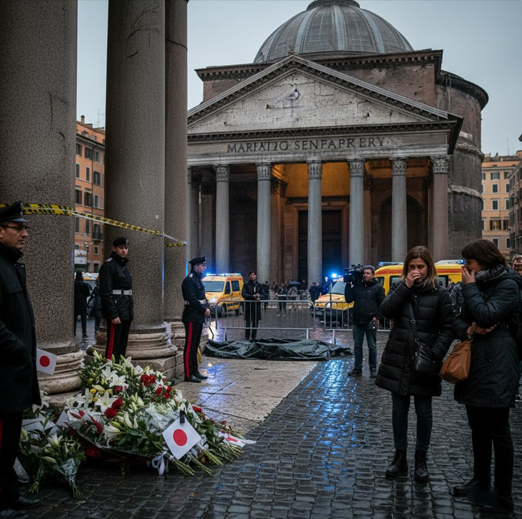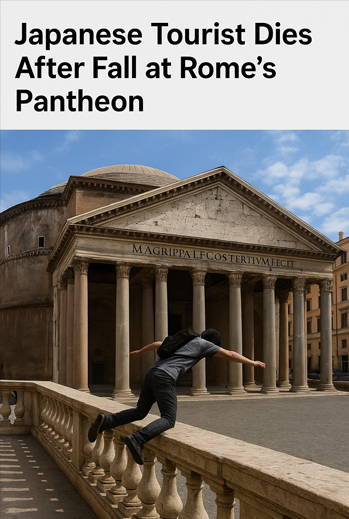Premium Biz Post – A wave of sadness spread across one of Italy’s most iconic landmarks this week after a Japanese tourist . The shocking incident raised serious concerns about visitor safety at ancient monuments and sparked global discussion about how to balance preservation with protection.

The Tragic Fall
Italian media reported that the accident happened early Thursday morning. The victim, a 39-year-old Japanese national, lost balance while exploring the upper corridor of the Pantheon. Witnesses said he was taking photos near a restricted section when he suddenly slipped and fell several meters.
Emergency responders arrived within minutes but couldn’t save him. The tourist died at the scene from severe injuries. Surveillance footage confirmed that the fall was accidental, and authorities ruled out foul play. After the accident, officials temporarily closed the Pantheon to investigate and inspect safety conditions.
Rome’s mayor, Roberto Gualtieri, sent condolences to the victim’s family. He also promised to review safety measures across all major heritage sites. “The Pantheon belongs to the world, but every visitor’s life matters most,” he said in a statement.
A Monument with Ancient Risks
The Pantheon, built almost 2,000 years ago, remains one of the best-preserved structures from ancient Rome. Once a temple for all gods, it now serves as both a church and a major tourist attraction, welcoming more than 9 million visitors every year.
However, its age presents safety challenges. The narrow staircases, slippery stone floors, and low railings create risks for visitors. Experts and government officials have debated how to improve safety without harming the monument’s authenticity.
The Ministry of Culture had already been studying upgrades to accessibility and crowd control. After this tragedy, those plans will likely accelerate. Authorities may restrict access to certain areas, add clearer signs, and increase supervision.
Eyewitness Reactions
Visitors who witnessed the fall described the scene as shocking. A French couple saw the man moments before the accident. “He stood near the inner ledge for a photo,” one said. “Then he slipped. It happened so fast that no one could react.”
On social media, many users expressed grief and frustration. “These sites need stricter control,” wrote a user from Japan. Others pointed out that preservation laws often prevent installing visible barriers in historic places.
Travel experts reminded tourists to be more cautious. “Ancient structures are fragile and unpredictable,” said Dr. Martina Russo, a tourism researcher. “No photo is worth risking your life.”
Tourism and Safety in Rome
Rome attracts millions each year to see the Colosseum, the Trevi Fountain, and Vatican City. Yet the city has struggled to balance booming tourism with visitor safety.
In the last few years, the Colosseum added new barriers after several minor accidents. The Vatican Museums also introduced digital crowd-control systems. Local tour guides now urge stronger enforcement of safety rules.
“Tourists often ignore warning signs because they want better pictures,” said guide Alessandro Moretti. “We must improve education and communication. Some instructions aren’t even translated properly.”
Read More : ”Patchwork Dolls Creative, Educational, and Eco-Friendly Crafts”
International Response
News of the tourist’s death quickly spread through Japanese and European media. Japan’s embassy in Italy confirmed the victim’s nationality and offered support to the family.
Japanese outlets highlighted the incident as a warning for travelers abroad. “Curiosity drives exploration, but awareness ensures safety,” wrote The Japan Times. Several travel agencies in Japan plan to release new safety guides for clients visiting historic sites in Europe.
The guides will encourage tourists to stay behind barriers, follow local rules, and wear proper footwear. They also recommend avoiding crowded areas during peak hours.
Preserving History, Protecting Visitors
The Pantheon’s administrators now face a tough decision: how to improve safety without changing the monument’s timeless design. Conservation experts warn that permanent metal barriers might damage its visual harmony.
Professor Lucia Valli from Sapienza University offered a middle ground. “We can use transparent or removable barriers,” she said. “Technology allows us to protect people and history at the same time.”
Cultural officials also discussed new ideas like 3D virtual tours and limited-entry time slots. These could reduce crowding while keeping the visitor experience authentic.
A Global Tourism Warning
The tragedy in Rome reflects a broader problem in global tourism. Heritage sites worldwide, from Machu Picchu to Angkor Wat, face similar risks. Each year, tourists suffer injuries or deaths due to falls, slips, or rule violations.
Modern tools could prevent such accidents. AI monitoring systems, sensors, and drones can alert staff when someone crosses into restricted zones. Travel influencers are also being urged to promote responsible behavior rather than dangerous stunts for social media content.
“Authorities can set rules,” said Dr. Pietro Mancini, a tourism policy expert. “But tourists must share responsibility. Respecting these places is part of honoring history.”
What Happens Next
The Pantheon reopened Friday with tighter supervision and new temporary barriers. Officials promised a detailed safety report within weeks. It will include updated visitor policies and proposals for structural adjustments.
Visitors have since placed flowers and notes near the entrance to honor the victim. Many paused to reflect on how fragile life is, even in a place built to last for eternity.
This tragedy will likely shape future policies for cultural heritage tourism. The event reminds both visitors and authorities that admiration for history must come with respect — and caution.



